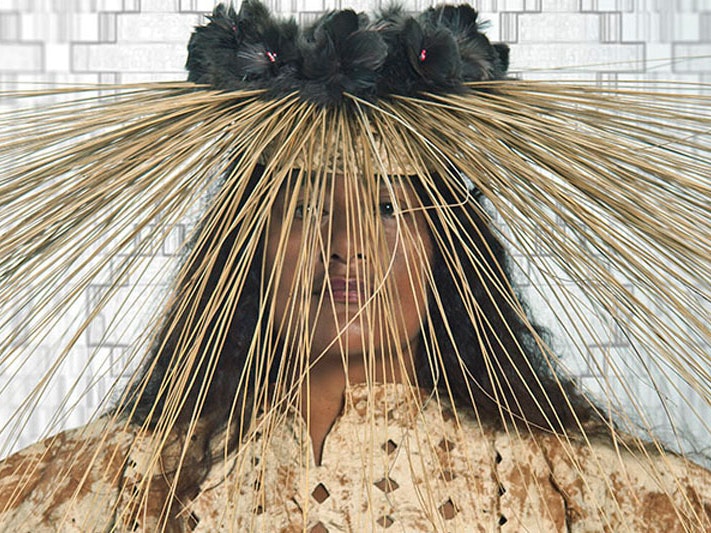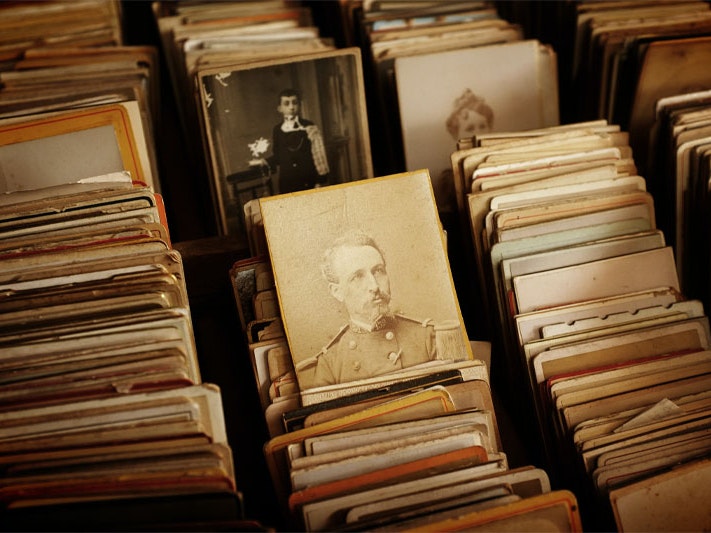
Rich task 2: Costume and identity
Discover the ways in which costume and adornment can be used to communicate who we are.
Free museum entry for New Zealanders and people living in New Zealand
Open every day 10am-6pm
(except Christmas Day)
Free museum entry for New Zealanders and people living in New Zealand
Explore colonial representations of Pacific peoples within art and the ways in which this has inspired contemporary artists to retell history.
We are examining how art can help us to understand dominant values, attitudes, and beliefs from the past and how these change over time.
Through these activities, learners will:
analyse the motivations behind the work of Joseph Dufour (1744–1829) and why Reihana wanted to respond to it within her artwork
consider what might need redressing within their own contexts.
Reihana created in Pursuit of Venus [infected] in response to wallpaper panels she saw by the French entrepreneur Dufour, called Les Sauvages de la Mer Pacifique. You can see part of it above, or view the whole design below. The wallpaper was an idyll – an imagined Pacific world created for European enjoyment.
When Reihana saw it, some 200 years later, she ‘couldn’t see the Pacific anywhere’. Reihana did not recognise the people as Māori and Pacific peoples.
Jean-Gabriel Charvet, Les Sauvages de la Mer Pacifique (The native peoples of the Pacific Ocean), 1804-5, Mâcon, woodblock printing, stencilling and hand-brushed gouache on paper. Purchased 2015 with Charles Disney Art Trust funds. Te Papa (2015-0048-1)
Download a high-resolution image of Les Sauvages de la Mer Pacifique on Collections Online
This provided the inspiration for her artwork in Pursuit of Venus [infected], which retells this time in history from indigenous perspectives. The artwork is often referred to in shorthand as iPoV, which also references an indigenous point of view.
In this activity, learners record their very first ideas about the wallpaper, developing art analysis and observation skills. It is designed as a discovery task – no prior knowledge is required.
The vast majority of Europeans who saw Les Sauvages de la Mer Pacifique knew very little about the Pacific. It was their first glimpse of a ‘utopia’ on the other side of the planet. Emulate this by asking learners to roll up an A4 piece of paper to make a long, narrow viewing tube, or ‘telescope’, and examine the Dufour panels as if they are art detectives searching for answers. Put on some chilled out classical music in the background as learners soak up the wallpaper panels on their own.
After their silent-sleuth study, arrange everyone into groups of four, and provide each group with just one set of the art-analysis questions below to discuss as a group. (Emphasise that they are guessing from their detective work, and they will not yet have firm answers.)
Content – the ‘why’
Why do you think the artist created it?
What does this art make you think of?
What questions do you have for the artist who made it?
Form – the ‘what’
What do you see when you look at it?
What kinds of shapes, colours, form, and scale are used in this work?
How would you describe the landscape, the people, and the costuming to someone who couldn’t see the painting?
Mood – the ‘when’
When people see this in real life, how would it make them feel?
If this work of art was alive, what noises and smells would surround it?
When do you think this scene happened? What makes you think that?
How does it make you feel? What does it remind you of?
In this activity, learners layer on extra information to their initial ideas, clarifying and solidifying their understanding of the artwork, before creating a clothesline of their ideas.
Within each group, or as a class, watch the TVNZ news article about the Dufour panels arriving at Te Papa in 2016. Ask learners to carefully listen for any new pieces of information that will help them to further answer their set of questions.
Once the group have fully discussed the clip, and perhaps rewatched it, each group then presents their findings on paper, creating an Art Detective Sleuth Sheet that records the questions and answers. Have each group present their ideas back to the rest of the class, and allow discussions to add in additional questions, thoughts, and details. Create a clothesline by running a string across the classroom and peg up colour images of Dufour’s wallpaper, followed by each group’s work.
There may be some learner-generated questions that come from this process. Record these visibly, perhaps presenting a question wall in the classroom, or adding additional questions to your clothesline. Use these questions to help guide your inquiry tasks, and ensure that these questions are answered.
In this activity, learners discover how the wallpaper inspired Reihana and consider the things that they might like to change within their world, life, or community.
As a class, listen to what Reihana thought when she saw the panels for the first time. In what ways were Reihana’s thoughts the same or different to the learners’ own ideas about the wallpaper?
Listen out for the moment in the video where Reihana speaks about ‘the moment it hit me in the guts’. Discuss what this means – how sometimes we can have such a strong emotional response to a moment in our life that we can feel it in our physical body. Reihana was motivated to ‘correct’ the ways in which Māori and Pacific peoples had been represented.
Spend some time exploring what the local community is currently trying to address. What are council, iwi, charitable, community, or environmental groups addressing within your neighbourhood? Learners may like to invite some people in, or onto Zoom, to speak about their work. What are the social or environmental issues that are ‘hitting them in the guts’? Ask learners in pairs to discuss and write down together the issue that they would most like to address through this inquiry. Perhaps have a post box available so learners can contribute their ideas safely.
In pairs, learners list the ways in which a wrong can be righted. Learners could use a simple example of friends fighting, and from that draw some conclusions about the types of practices that bring reconciliation and healing.
Discuss how Reihana wanted to create a more authentic representation of Māori and Pacific peoples than the way they had been represented in the past. This was her motivation for in Pursuit of Venus [infected]. This idea – of correcting problematic representation – can collectively inspire many directions, particularly in relation to media:learners could explore the ways in which identity is represented by media, reviewing the ways in which the same story is reported across different sources (for example, a mainstream news source, an influencer, a Māori news source)depending on their age, learners could do an audit of their social media to consider how representative their feeds are; what is the composition of male, female, nonbinary, Pacific, Māori, and diverse voices that they follow?learners could gather advertising images from a variety of sources and annotate them, identifying the shortcuts advertisers use to communicate an idea about who someone is.depending on the age of learners, this conversation (between curators Puawai Cairns and Nina Tonga at the time of the Venice Biennale Arte 2017 exhibition) may be useful as a further prompt for discussing history, the ways in which it was recorded in pre-colonial times in the Pacific and Aotearoa, and what we might want to be aware of going forward.
What are three questions you have now that you didn’t have before this task?
In what ways could this inquiry contribute to or serve work that is currently underway to address injustice?
Explore the website for Reihana’s Venice Biennale Arte 2017 exhibition, Lisa Reihana: Emissaries, at which in Pursuit of Venus [infected] was the central artwork.
Listen to Reihana speak about her fascination with Dufour’s wallpaper (start from 20 minutes in).
Discover some of the highlights of Te Papa’s significant Pacific collection, from contemporary artworks merging Māori, Greek, and Roman mythology to an ‘ahu ‘ula (feathered cloak) that was once draped over the shoulders of Captain James Cook.
Use this article to assist in analysing the views, values, and actions taken in our history.
Download the First Collisions teaching and learning resource from Te Papa, which guides discussion on the encounter history of Aotearoa.
Watch a video about the early encounters that happened here, on the Aotearoa History Show, a YouTube production funded by NZ on Air and Radio New Zealand.
Watch this episode of Tales from Te Papa about the Banks and Solander Collection, which helps to explain the function of Cook’s voyages.
Watch David Attenborough speak about the legacy and importance of Joseph Banks’ work.

Discover the ways in which costume and adornment can be used to communicate who we are.

Examine local histories in your own context, considering the ways in which dominant narratives can be addressed.
![On the set at LOT23 Studio, Auckland, during shooting for in Pursuit of Venus [infected], 2014. Photo by Kallan McLeod. Courtesy of the artist Green screen behind the scenes of iPoV](/assets/76067/1693436757-f20-reihana-collating-insights-tile.jpg?ar=1.3333333333&fit=crop&auto=format)
Use simple activities to ensure the insights gained from the Explore kete are ready to inform a creative response.